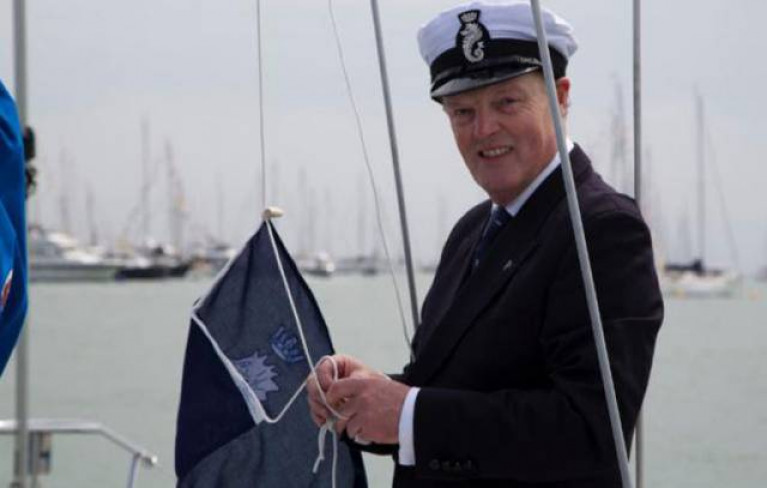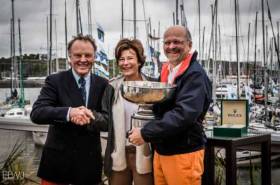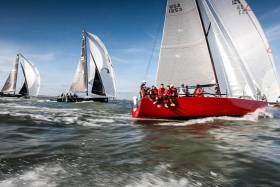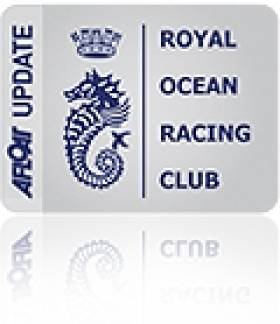Displaying items by tag: Michael Boyd
Royal Irish Yacht Club skipper Michael Boyd finally got his hands on the Volvo car prize after accumulating the best overall points’ results on corrected time in the biennial Round Ireland races 2016, 2018 and 2022.
To add to the drama, Boyd had to wait an extra four years for his prize bid due to COVID cancelling the 2020 race.
And if that wasn't enough, in the end, the race for the top prize in Irish sailing came down to the wind and a Protest Committee on June 23rd in the final stages of the 21st edition.
 Michael Boyd's Darkwood clinched the Volvo car prize in the 2022 Round Ireland Race Photo: Afloat
Michael Boyd's Darkwood clinched the Volvo car prize in the 2022 Round Ireland Race Photo: Afloat
Boyd raced three different boats in the last three circuits. The offshore racing stalwart sailed the Beneteau 44.7 Lisa in 2016, the J109 Jedi in the 2018 race and the J122 Darkwood to clinch the car in June's 2022 SSE Renewables sponsored race.
During the 2022 race, Boyd took the opportunity to pay tribute to lost rescue service personnel off Eagle Island.
Boyd was presented with the keys of his new Volvo XC40 by David Thomas, Managing Director of Volvo Car Ireland and Kyran O’Grady, Commodore of Wicklow Sailing Club.
Irish Crew on Board J121 Darkwood for RORCs Cervantes Trophy May Be Round Ireland Race Warm Up
A top UK-based offshore racer will race this weekend's Cervantes Trophy with a strong Irish crew, which will heighten prospects of a potent Round Ireland Race entry in June.
In a crew list seen by Afloat for Dubliner Michael O'Donnell's UK based J/121 Darkwood leading Irish offshore sailors Kenny Rumball, Michael Boyd, Barry Hurley, and Conor Kinsella are on board for Saturday's 160nm offshore race from the Royal Squadron Line in Cowes across the English Channel bound for Le Havre.
As Afloat reported earlier, over 50 teams are expected at the oldest yacht club in France, Société des Regatés du Havre on Sunday. The race is the traditional opening domestic race of the RORC Season’s Points Championship.
Although there is no entry received so far by Wicklow Sailing Club for Darkwood in the biennial Irish offshore race, Afloat sources say the same crew will also compete in June's RORC's Myth of Malham race before positioning to Ireland for the June 18 circumnavigation.
 Michael O'Donnell's J/121 Darkwood was the 2019 Royal Ocean Racing Club Channel Race winner Photo: Paul Wyeth/RORC
Michael O'Donnell's J/121 Darkwood was the 2019 Royal Ocean Racing Club Channel Race winner Photo: Paul Wyeth/RORC
As previously reported, Royal Irish Yacht Club skipper Boyd leads the race for a Volvo Car prize in this year's edition of the SSE Renewables Round Ireland Race, but only three points separate the top four skippers overall.
The prize was to be decided after the 2020 edition of the offshore classic, but that edition was cancelled due to COVID.
According to the race rules, the skipper who has accumulated the best overall points' results on corrected time over the three Round Irelands 2016, 2018 and 2020 will be presented with a brand new Volvo V40 or equivalent at the prizegiving for the 2022 Race.
As Afloat reported back in 2020, the current leaderboard shows Dublin Bay sailor Michael Boyd, a Round Ireland stalwart, who sailed the J109 Jedi in the 2018 race and the Beneteau 44.7 Lisa in 2016 on 16 points overall. Royal Cork skipper Ian Hickey on Cavatina is next on 19 points and shares the same points with Rob Craigie from the Sunfast3600 Bellino and 2019 ISORA Champion Paul O'Higgins, the skipper of the JPK10.80 Rockabill VI, also on 19 points.
Michael Boyd is February “Sailor of the Month (Offshore)”
Michael Boyd of the Royal Irish Yacht Club may have first leapt to prominence in offshore racing with his overall victory in the 1996 Round Ireland Race in the J/35 Big Ears. But his enthusiasm remains undimmed with achievements including the RORC Championship and other Round Ireland results well in the frame, and in late February he added yet another laurel with a key role in the interesting Lombard 46 Pata Negra’s class win in the RORC Caribbean 600 Race.
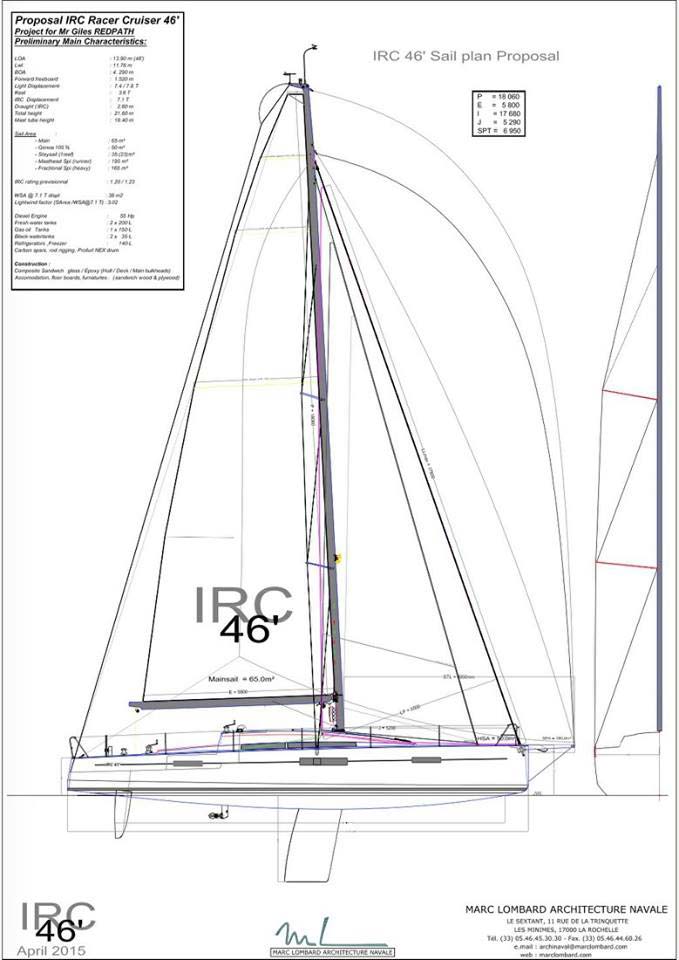 The “interesting” Lombard 46 Pata Negra has served Irish crews well in the RORC Caribbean 600
The “interesting” Lombard 46 Pata Negra has served Irish crews well in the RORC Caribbean 600
Boyd, King & Murphy on 'Pata Negra' Are Vying for RORC Caribbean 600 Lead
Michael Boyd is chasing the overall lead on board Giles Redpath’s Lombard 46 Pata Negra after the first 100 miles sailed in the 12th edition of the RORC Caribbean 600, organised by the Royal Ocean Racing Club in Antigua.
The proven Pata Negra lies second in IRC One and third overall on IRC in a gentle start to the race yesterday.
Three Irish sailors are on Pata Negra, some of ten Irish competing in this week's race. As well as former RORC Commodore Boyd, 1996 Olympian Marshall King (and more recently a J70 champion) and James Murphy are all onboard.
It is the fourth Caribbean 600 race for the Round Britain and Ireland winner. Redpath is joined by an experienced group of inshore and offshore sailors - a mix of professionals and good friends who all have all sailed with him on Pata Negra.
The Lombard 46 was third in class in 2019 and second in ’the 18 race under Michael Wright of Howth Yacht Club. Andy Lis is boat captain and he will be backed up by Will Harris as navigator, Sam Matson on trim and Royal Irish's Boyd on the helm.
Race Start
The impressive 73-boat fleet gathered outside Antigua's English Harbour, relishing the prospect of racing 600nm in stunning conditions. A light south-easterly breeze gave a gentle start to the race, but the fierce competition was exemplified by highly competitive starts right through the fleet. Lighter than usual conditions are forecast for the first 24-hours of the race, adding another level of strategy to the fascinating race around 11 Caribbean islands.
First to go was the combined IRC Three and IRC Two fleet of 26 boats. The second start was for IRC One and the Class40 division, featuring 23 teams. The IRC Zero start featuring 17 of the fastest monohulls in the race was highly aggressive. The Multihull start featured eight teams.
Tracker here
Representatives of the International Rating Certificate (IRC) from around the world met in France for two days of debate and discussion at the beginning of October.
The 2019 Congress was hosted by l’Union Nationale pour la Course au Large (UNCL) and the Société des Régates d'Antibes, and delegates arriving into Nice airport enjoyed an aerial view of the racing at Les Voiles de St Tropez.
Congress 2019 was chaired for the first time by Irishman and former Royal Ocean Racing Club (RORC) Commodore Michael Boyd, supported by Vice Chairs Malcolm Runnalls, and Carl Sabbe (BEL). Delegates gathered from Australia, Belgium, Canada, France, Great Britain, Ireland, Japan, Netherlands, Turkey and the USA; and from organisations including RORC, UNCL, the Royal Yachting Association and the International Maxi Association.
The annual conference provides a good forum for IRC owners’ representatives and administrators from many countries to share experiences and ideas from different perspectives and racing cultures; this year was no exception with both formal and informal discussions taking place over the weekend. In additional meetings, the IRC Congress agreed on a number of developments for 2020 as a result of research by the Technical Committee throughout the year, while the IRC Policy Steering Group reinforced the good relations between RORC and UNCL, joint owners of the IRC Rule.
"The 2020 IRC European Championship will be hosted by the Royal Cork Yacht Club as part of the club's 300th anniversary year"
All at Congress agreed that great events drive participation, and it was interesting to hear of initiatives aimed at increasing IRC fleets, particularly amongst cruiser-racers. For those aspiring to IRC Champion status two events confirmed for 2020 are the IRC European Championship in Ireland in July, hosted by the Royal Cork Yacht Club as part of the club's 300th anniversary year, and the ORC/IRC World Championship hosted in Newport by the New York Yacht Club in September.
IRC rule changes approved for 2020 include rules relating to whisker poles, the input of list angle for water ballasted boats, the definition of bulb weight and several housekeeping items. The Technical Committee have agreed an enhanced formulation for 2020 to improve the treatment of different fin keel types and water ballasted boats and the rating of whisker poles. In addition, research on flying headsails (also referred to as ‘code zero’ headsails) has made excellent process and the intention is to publish a definition early in 2020 and offer trial certificates later in the year.
The Congress Minutes and associated documents including IRC 2020 Rule changes are online here
Michael Boyd is “Sailor of the Month (Offshore) for August
Michael Boyd of the Royal Irish Yacht Club is so successful in his multi-tasking as an impressive Commodore of the Royal Ocean Racing Club, and a very competent and frequently-competing skipper in in its annual 12-race Mainseries Points Championship, that we risk taking his achievements for granted.
Yet in August he excelled himself with a brilliantly consistent Fastnet Race, well-placed at both the Rock and the finish in skippering the First 44.7 Lisa to place second in class, and becoming far and away the leading Irish skipper to win the Gull Salver and become our “Sailor of the Month (Offshore)” for August.
But the duties were only beginning for the RORC Commodore as the Fastnet finishers in this record fleet crossed the line. In Plymouth he recorded an early-morning video just after finishing which so eloquently expressed the deeper meaning of this great race that he spoke for all competitors in a memorable display of quiet yet very committed enthusiasm.
In this current weekend, Boyd and his crew – with includes some other noted Irish offshore racing names – are shaping up to place well in the RORC’s penultimate race of the 2017 season. But we would remind everyone that September finished on Thursday, Afloat.ie then take two days for the adjudication process, and our current batch of awards refer only to achievement in August.
It has been confirmed by the Irish Cruiser-Racing Association (ICRA) that it’s extremely unlikely that Ireland will be mounting a defence in July 2016 of the RORC Commodore’s Cup, which we so convincingly won in 2014 with the team of Catapult, Antix and Quokka 8. Apparently the defence has foundered on the difficulties of finding a person or group willing to take on the campaigning of a third boat which would be suitable to back up Anthony O’Leary’s 2014 Ker 40 Antix (ex-Catapult), and Michael Boyd’s new JPK 10.80. Michael Boyd and Anthony O’Leary had lined up a possible charter of Quokka 8 on a speculative (and expensive) retention fee in the hope that a team of optimal make-up could take shape, but no-one has proved willing to take up the costly full-charter option to make her the third boat. W M Nixon reflects on this unhappy follow-up to a good news story which helped lift Ireland out of the gloom of the recession in 2014.
The Commodore’s Cup 2016 as a Sail Training exercise? It’s one of the less crazy scenarios which is emerging from the conclusion that a realistic and highly-powered defence of Ireland’s 2014 win is simply not on the cards. The word is that the two front-line boats have been unable to find people with mega-resources and a crew willing to take up the third slot with Quokka, or possibly another boat altogether. Thus all bets are off.
To outsiders, it all sounds like a bit of the old hissy-fits, and more. Surely something could have been done? But those who have been in the midst of the Commodore’s Cup cauldron have some idea of both the stress involved (which is huge at the front of the fleet), and just how very much it is more important than ever to have a finely balanced team.
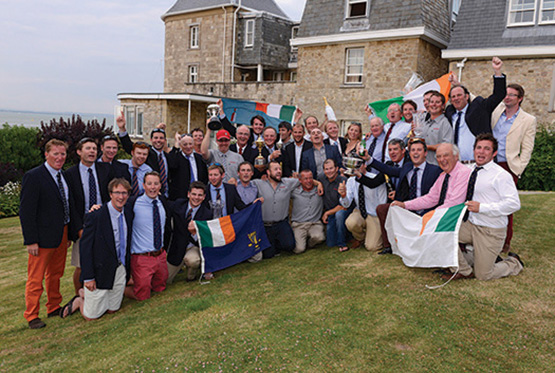
The big day – the Irish team park their tanks on the Royal Yacht Squadron lawn in Cowes after winning the Commodore’s Cup, July 2014
It all looked so easy once 2014’s win had been stitched up. But as the post-series review here on August 2nd 2014 revealed, the stresses and strains – particularly on Anthony O’Leary who did the heavy lifting in putting the team together and keeping the show on the road – were beyond most people’s imagining.
With hindsight now, it is easy to say that it was somewhere back towards Easter this year that the writing on the wall began to appear about how Ireland was going to have to opt out of the 2016 series. The new wave of Fast40+ boats on the Solent in the RORC Easter Challenge had been giving the already senior Antix a very hard time. If Anthony O’Leary and his crew were going to give of their best in campaigning their own boat in what is rapidly emerging as the hottest class in Europe, then they didn’t really need the distraction of rustling up a Commodore’s Cup team to add to their struggles.
For sure, back in 2014 the Commodore’s Cup was top billing. But the remorseless growth of the Fast 40s is making them the top show in town for 2016. They’d seven or eight of them in serious contention last year. At Easter, it was 10 and 11 boats, many of them barely out of the wrapping. In two weeks time, when they have their next major three day event on the Solent from May 20th to 22nd, we will be looking at a dozen and more boats so hot you could fry an egg on them.
Numbers like this, at this level of competition, inevitably attract the heavy hitters among owners and top professional sailors, providing a challenge which you either take head on, or opt out of altogether. For the amateur crew of Antix, it’s a case of take it or leave it. In taking it with full commitment to Fast40+ racing, they simply have to accept that they can’t overload themselves by the extra effort of running Commodore’s Cup involvement, though perhaps they could contemplate being in an Irish squad if by some miracle the perfect team package is put completely and exactly in place by some sort of offshore racing fairy godmother.
But you don’t get fairy godmothers in the rough tough world of offshore racing. The perfect dream package isn’t there, and it won’t be. So Antix and her crew of dedicated amateurs are going to be in the David and Goliath situation of throwing themselves totally into the fray of the Fast 40s, and we can only hope that the original David and Goliath scenario is replicated, for this is definitely the big boys’ game.
And yet, and yet……there’s no such thing as an inevitable outcome. Who knows what might emerge from the first proper gladiatorial confrontation of the Fast 40s in their newly confident expanded numbers? We may be saying this morning that an Irish defence is over and out. But surely it’s not beyond the realms of possibility that in the heady post-regatta atmosphere at the RORC’s Cowes base in a fortnight’s time, somebody might say: Why don’t we as a crew take a boat and join up with Antix and the new JPK 10.80 to race for Ireland?

The JPK 10.80 Courier du Leon wins the 2015 Rolex Fastnet Race
Stranger things have happened in putting Commodore’s Cup teams together in the past. In 2014, so speculative was the buildup that Anthony O’Leary admitted afterwards that until the American Ker 40 Catapult was actually unloaded from a Transatlantic ship on European soil, he wasn’t a hundred per cent convinced she was going to appear at all.
Yet ironically, there was Catapult on the quay as hoped for, after various dockside and clubhouse meetings and negotiations in Key West way back in January. But the whereabouts of the team’s third boat Quokka 8, which had been chartered by Michael Boyd and Niall Dowling, was now a matter for concern.
She’d been campaigning in the Caribbean through the winter, but had been scheduled to be shipped back in plenty of time for the start of the new RORC offshore season. But the ship she was aboard was re-routed, then re-routed again. She arrived back this side of the Atlantic barely in time for the team’s first get-together at Volvo Cork Week in July 2014. But then it all became sweetest fantasy, as Quokka won Volvo Cork Week overall, following which the Irish team won the Commodore’s Cup going away.

Quokka 8, overall winner of Volvo Cork Week 2014
So who knows what might just somehow develop. But meanwhile the critics are sharpening their knives, and there’s much muttering about it being disgraceful that Ireland doesn’t look like defending a trophy we were so pleased to win just two short years ago.
Thus a suggestion is floating around that ICRA should be prepared to allow just about any old team to go and join the scrap for the Commodore’s Cup 2016. Why not, they suggest, just allow three J/109s to go along to represent the Ould Sod, and give their crews a real taste of sailing at the sharp end?
Certainly the Commodore’s Cup as a Sail Training event has a distinct Quixotic appeal. But underneath the whole story is the reality that while in places like the Solent the top end of high-profile sailing is invariably dominated by professionals, within and around Ireland we don’t really do professional competitive sailing at all.
We’re compulsive and obsessive amateurs, and that’s the way we like it. If our sailing isn’t fitted in to cherished little slivers of free time carved out of the day job, then we don’t really think it’s genuine sport at all. Thus while it’s fine and dandy every so often to take on the Solent heavies and maybe just occasionally show them the way, we’d just as soon save our limited holiday time for a proper tilt at the West Cork Regattas or events like the ICRA Nationals, where we’re racing against people we know, and not shelling out money for exorbitant Cowes rentals. Like it or not, that’s the way we are.
Meanwhile, it’s rumoured that the 2018 Commodore’s Cup will be based of teams of just two boats each. Now they tell us…….But that’s not teams. That’s multiple doubles matches.
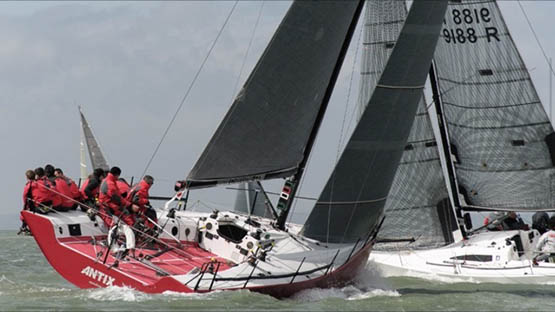
A demanding animal to sail. The tiller-steered Ker 40 Antix is not for the faint-hearted
Read also: ICRA Statement on 2016 Irish Commodore's Cup team
RORC Defends IRC Handicap Following Irish ORC Presentation
The Royal Ocean Racing Club (RORC) in London says a 'correction is needed' over information contained in an article following an ORC presentation at the ICRA Conference in Limerick, a week ago. Michael Boyd, the Commodore of RORC, says the offshore body 'read with interest', and 'some confusion', the press release by the ORC. Boyd says he feels 'very strongly' that information put forward by Dobbs Davis, Chairman of ORC’s Promotion and Development Committee, 'needs correcting'.
In a statement issued by RORC, who administer the rival IRC system, the club says:
First, the numbers presented are wrong. Dobbs quotes the number of ORC certificates in total up until the end of the year, but only quotes the number of boats in IRC until the end of August of 2015. These are very different figures. Dobbs quotes 4958 for IRC in 2015 but the real number of certificates for the whole year is 7721. That makes the graph look very different and makes IRC the largest individual system in 2015 with ORC Club behind it at 7404 and ORCi trailing at 2492.
It should also be noted that both IRC and ORC are International Rating Systems recognised by World Sailing and IRC is currently in discussions with World Sailing about having its own World Championship. Rather than having two world championships for offshore boats, we are supporting the WS initiative to have one jointly scored IRC/ORC world championship which will allow the event to travel to other continents.
IRC is expanding with new territories in India and Taiwan, growth in Japan and China and very encouraging numbers for the start of the year from many Northern European countries.
IRC is also flexible and not limited to using time-on-time scoring - as has also been suggested. A simple time-on-distance calculation can be applied to create a time-on-distance value, should race organisers want to use it. Similarly, crew number or crew weight can be applied depending on the race organiser’s needs and wishes.
IRC is doing a great job for our sport – you only have to look at the style of boats that have developed since the demise of IMS (the basis of ORC) to understand that IRC is a progressive rule – with the latest generation of boats being fast, safe and fun to sail. Our goal is to ensure that we provide a first class service and develop a product that is constantly evolving to make sure that racing under IRC is as fair as is possible.
- Michael Boyd, Commodore, ROYAL OCEAN RACING CLUB
RORC Chief To Contest Round Ireland Yacht Race
Michael Boyd, the Commodore of the Royal Ocean Racing Club and current holder of the Commodore’s Cup, will return to compete in the 2016 Volvo Round Ireland race, marking the 20th anniversary of his win, with many of the same crew from his 1996 winning yacht, Big Ears.
The 18th Volvo Round Ireland Yacht Race is set to be one of the most heated editions in the race’s history say organisers with a number of prestigious international sailing champions announcing they will contest this year’s edition.
Michael Boyd's choice of a J/35 as his first serious offshore racer was a shrewd decision 20 years ago. He won the Round Ireland in style with Big Ears and more recently the J/35 model has been one of the few exceptional boats to be inducted into American Sailing's Hall of Fame. In the 1996 race Boyd and his crew, minus one removed to hospital off Kerry with fractured ribs, played every tiny gain to beat Roy, Dickson's Beaumont Spirit on Channel handicap, the deciding system for determining the overall race winner.
Twenty years later, the race received a major boost before Christmas with Volvo Cars Ireland coming on board as title sponsor this year after four years without sponsorship.
Phillip Johnston has also confirmed that he will be entering the impressive Open 60 Artemis-Team Endeavour, the current holder of the Round Great Britain and Ireland Race, under skipper Michael Ferguson.
The current holder of the Fastnet Race's Roger Justice trophy Rónán Ó Siochrú has also confirmed that he will be back to contest the Round Ireland for the fourth time.
At the end of 2015 internationally renowned sailor and US businessman, George David also announced his intention to enter his yacht Rambler 88 into the 2016 race. The canting keel maxi yacht would be a strong contender to break the Volvo Round Ireland Race record of 2 days 17 hours 48 minutes 47 seconds which is held by Mike Slade in ICAP Leopard 3 achieved in 2008.
Meanwhile, following the announcement that 2016 will be the first time that multihulls will be invited to compete, Team Concise have already indicated their intention to enter their world-class fleet. Ned Collier Wakefield, Team Director and Skipper for Team Concise, has indicated that they intend entering their 3 boats into the 2016 Volvo Round Ireland – the MOD 70 and their 2 Class 40 boats.
The Race only officially opens for entries next Monday (18th January 2016), however with the quality of entries already at such competitive levels, Race organisers expect the 2016 Volvo Round Ireland to be one of the most competitive and exciting races ever, attracting serious quality sailors and some of the finest yachts from across the world.
Race organiser Theo Phelan:
“We have further expressions of interest from some really exciting names that we hope to be in a position to announce in the coming weeks. Already the competition is heating up and we expect many previous race entrants to return to contest what is set to be one of the most exciting races ever.”
“The new Volvo Cars title sponsorship is a paramount development in the expansion of the race, which allows us to plan ahead for the significant growth of the race in the coming years.”
The 2016 Volvo Round Ireland departs Wicklow Bay on Saturday 18th June 2016 with the first start at 13.00 hours.
Trentesaux Victory in RORC's De Guingand Bowl Race
#rorc – A good mix of 89 British and French yachts started the Royal Ocean Racing Club's De Guingand Bowl Race on Friday evening, heading (eventually) to a sunny Cherbourg writes Race Reporter Louay Habib. Racing under the IRC rating system, the French JPK 10.80 'Courrier du Leon' sailed by Géry Trentesaux was the overall winner. This was his third win in the RORC Season's Points Championship, and he retains the overall lead for the 13 race series.
"It was a great race with a beautiful start, we were under spinnaker all the way to Brighton." commented Géry Trentesaux. "We had a good upwind course around the Isle of Wight to the Needles, I think that we did very well upwind. Courrier Du Leon is a good offshore boat, not especially fast in the light downwind but upwind the boat has good performance. I have been sailing with good crew for 20 years and we have three Figaro sailors on board for this championship, who are great all-round sailors and comfortable in a smaller boat. This race did suit the smaller yachts, as we arrived in Cherbourg at maximum speed with the tide; but judging the tide in the Channel is very difficult as the wind can vary so much. The course was excellent for this race, perfect for the conditions."
Le Havre skipper Noel Racine, racing JPK 10.10 Foggy Dew, was the winner of IRC Four and second overall. Louis-Marie Dussere, also from Normandy, racing JPK 10.10, Raging Bee, was the winner of the IRC Two Handed Class. Raging Bee now has a commanding lead in the two handed division for the season. Michel Peretie's French A40, Stamina III, was the winner of IRC Two, taking line honours for the class.
British success in the De Guingand Bowl Race came for Nick Jones from Chichester, Sussex, racing First 44.7, Lisa. Nick and his team won IRC One and was placed third overall. Two British yachts returning to RORC racing this season were also victorious. Philip Rann's Frers 92, Bristolian, skippered by John Burnie, was the winner of IRC Zero and placed fourth overall. Tony Lawson's Concise8, skippered by Jack Trigger, won the Class40 division, and Hampshire skipper John Allinson, racing J/109 Jumbuck, was third in IRC Three, beating seven other J/109s to Cherbourg.
The race committee led by RORC Racing Manager Nick Elliott, set a 146-mile course for the De Guingand Bowl Race. Starting between two committee boats, east of Cowes, the fleet headed east out of the Solent past No Man's Land Fort, Owers and Rampion Met Mast before returning to Owers then past St.Catherine's Point. Along the south side of the Isle of Wight the fleet encountered a variety of wind conditions, on their way to the Needles Fairway Buoy, before heading south to cross the English Channel. IMOCA 60, Artemis Ocean Racing, skippered by Mikey Ferguson, took line honours for the race, completing the course in under 13 hours. Most of the fleet took 20 hours or more to complete the race.
Nick Jones', skipper of Lisa, winner of IRC One and third overall had good reason to finish the race quickly. "When you have Géry Trentesaux closing in from behind in a little boat and the Maxi Bristolian long disappeared over the horizon, you don't really expect to come third overall, so it was a bit of a surprise to get on the podium. Judging the tide across the channel was key, we have done it so many times before but you have to factor in the wind strength. We had about 12 knots at a 50 degree wind angle and we were confident that this was stable, but we hedged our bets a little earlier on. But hour by hour we changed our tactics and eventually put the bow down and went for it. As I say, a bit of a surprise to do so well overall but I personally I had another incentive, my wife Suzie couldn't be with us as she is about to give birth to our first child but I have managed to make it home before the arrival.
After the race, an informal Prize Giving was held at the Yacht Club de Cherbourg attended by over 200 sailors. Bottles of Champagne were given to prize winners by RORC Commodore Michael Boyd. Racing for the RORC Season's Points Championship continues with the East Coast Race from Burnham to Ostend on the 12th June.




























